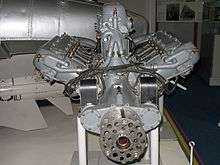W engine
A W engine is a type of piston engine where three or four cylinder banks use the same crankshaft, resembling the letter W when viewed from the front.[1][2][3]
W engines with three banks of cylinders are also called "broad arrow" engines, due to their shape resembling the British government broad arrow property mark.[1][4]
W engines are less common than V engines. Compared with a V engine, a W engine is typically shorter and wider.
W3 engines
One of the first W engines was the Anzani 3-cylinder, built in 1906, to be used in Anzani motorcycles. It is this W3 engine which also powered the 1909 Blériot XI, the first airplane to fly across the English Channel.
The Feuling W3 is a 2.5 L (153 cu in) motorcycle engine that was built by an aftermarket parts company in the United States in the early 2000s.[5] Like radial aircraft engines it has a master connecting rod and two slave rods connected to the pistons.[6]
W8 engines
The sole W8 engine to reach production is the Volkswagen Group W8 engine automotive engine, which used a four-bank design and was produced from 2001-2004.
W12 engines

W12 engines with three banks of four cylinders were used by several aircraft engines from 1917 until the 1930s. A three-bank design was also used for an unsuccessful W12 engine which was intended to compete in Formula One in 1990.
Although less commonly used in automobiles than V12 engines, a W12 petrol engine has been produced by Volkswagen Group since 2001. This four-bank engine— based on two VR6 engines with a common crankshaft— has been used in various cars sold under the Audi, Bentley and Volkswagen brands.
W16 engines
W16 engines are rarely produced, with the notable exception of the Volkswagen Group 8.0 WR16 engine that has been used since 2005 in the Bugatti Veyron, Bugatti Chiron and their related models.
W18 engines

The W18 layout is rarely used, with the only production examples being several aircraft during the 1920s and 1930s.
See also
References
- Domonoske, Arthur Boquer; Finch, Volney Cecil (1936). Aircraft engines: theory, analysis, design, and operation (Engineering textbook). J. Wiley & Sons. p. 7. Retrieved 2014-04-25.
The W, or broad arrow engine, has three rows of cylinders of which the central row is vertical with the other two rows forming equal angles with the vertical.
- Taylor, Charles Fayette (1985) [1968]. The Internal-combustion Engine in Theory and Practice: Combustion, fuels, materials, design. Massachusetts Institute of Technology. ISBN 0-262-70027-1. LCCN 84028885. Retrieved 2013-12-17.
W engine is similar to a V engine but with three banks of cylinders. The two V angles are usually equal.
- Rajput, R. K. Internal Combustion Engines. New Delhi, India: Laxmi Publications. ISBN 817008637X. Retrieved 2013-12-17.
W-engine Same as V-engine except with three banks of cylinders on the same crankshaft.
- "The New Sunbeam Overhead Valve Type Engines", Aviation Week and Space Technology, McGraw-Hill, vol. 3, p. 32, 1917
- "About Us". www.feulingparts.com. Retrieved 4 November 2019.
- "Make Mine a Triple: The Feuling W3". Interlink Media. MotorcycleCruiser.com. October 2000. Retrieved 31 December 2009.